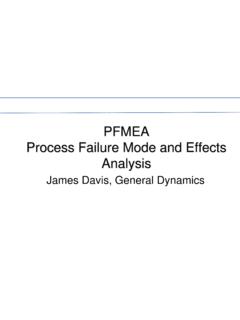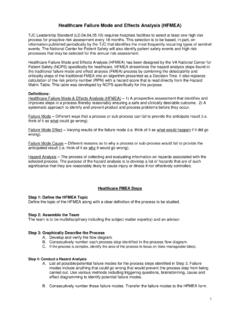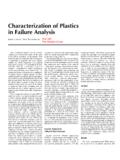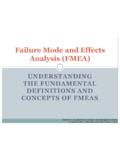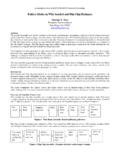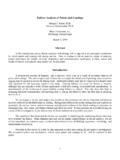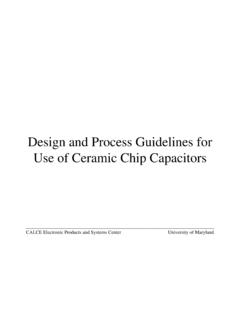Transcription of MECHANICAL VENTILATION INDICATIONS: …
1 MECHANICAL VENTILATION . indications : respiratory failure Cardiopulmonary arrest Trauma (especially head, neck, and chest). Cardiovascular impairment (strokes, tumors, infection, emboli, trauma). Neurological impairment (drugs, poisons, myasthenia gravis). Pulmonary impairment (infections, tumors, pneumothorax, COPD, trauma, pneumonia, poisons). GOALS: Treat hypoxemia Treat acute respiratory acidosis Relief of respiratory distress Prevention or reversal of atelectasis Resting of ventilatory muscles ENDOTRACHEAL TUBE: NURSING CARE. 1. Check placement by: Auscultate for bilateral breath sounds and observe for symmetrical chest expansion. Tube may be incorrectly positioned in R main stem bronchus or esophagus.
2 O Positioning in the R main stem bronchus may be indicated by breath sounds heard only on the right side and/or movement of chest wall noted only on the right side Upon initial insertion, placement can also be checked with an end-tidal CO2 detector. o To use the end-tidal CO2 detector, connect the ETCO2 between the ET tube and ambu bag. Ventilate the pt. with 6 breaths. Compare color indicator on end- expiration to color chart on the product dome. The color should be between Range B. and C to indicate tube is in the trachea. All placements must be verified with a PCXR correct position is tube tip located 3-5 cm above carina. (*For neonates, correct position is T2-T4. **For pediatrics, correct position is three (3) times the ETT size at the lip).
3 2. Assess for cuff leak: (*Not applicable for neonates, only uncuffed tubes used; For pediatrics, cuffs used only if pt. is > 8 years old.). Cuff on end of tube is high volume, low pressure cuff which is inflated using minimal leak to obtain adequate seal and reduce incidence of tracheal damage ( respiratory therapist will perform minimal leak check). Signs and symptoms of cuff leak: audible inspiratory leak over larynx, pt. talking, pilot balloon deflation and loss of inspiratory and expiratory volumes on ventilator Nursing Actions to take in case of cuff leak: Inject air into the pilot balloon using a TB syringe until pilot balloon re-inflated. Notify respiratory to check STAT and inform them of amount of air injected.
4 3. Suctioning/Oral care Artificial airways reduce pt's ability to cough and increase secretion formation in the lower tracheo- bronchial tree Secretions increase risk for obstructed airway, atelectasis, pneumonia and infection Suction as pt. condition dictates using closed system Advantages of closed system include: reduced arterial desaturation and infection Oral care (q 2-4 hr and prn) is important to decrease potential for infection such as ventilator associated pneumonia. Remember to suction oropharynx as well as down ET tube. *Suction depth for pediatrics is 1 cm below ETT, neonates cm below ETT. respiratory Therapist is responsible for making all vent changes, drawing ABG's, extubating per MD.
5 Order. At GMH, intubations may be performed by MD, anesthesiologist, CRNA, or trained resp. therapist. *In Neonatal ICU, intubations may be performed by MD, Neonatal Nurse Practitioner, Resp Therapist, and Transport Team members. **In Pediatric ICU, intubations may be performed by MD, Resp Therapist, and Transport Team members. 4. Elevate HOB 45 degrees to reduce potential for nosocomial pneumonias in mechanically ventilated pts. unless contraindicated by pt. condition ( blood pressure, etc ). POSITIVE PRESSURE VENTILATORS: Pressure cycle: Allows air to flow into lungs until preset pressure has been reached. Once this pressure is reached, a valve closes and expiration begins. Volume of air delivered varies with changes in lung compliance and/or resistance.
6 Volume cycled: Allows air to flow into lungs until a preset volume has been reached. Major advantage of this type is that a set tidal volume is delivered despite changes in compliance or resistance. Most commonly used disadvantage is potential for high pressure. Time cycled: Allows air to flow into lungs until a preset time then expiration begins. VENTILATOR CONTROLS: Fraction of Inspired Oxygen (FiO2): Amount of oxygen delivered to the patient. Adjusted to maintain O2 sat of > 90%. Concern with oxygen toxicity with FiO2 > 60% required for 12-24 hours. *In Neonatal ICU and Pediatric ICU, O2 sats may differ based on patient disease process. respiratory Rate: Number of breaths/min. ventilator is to deliver Tidal Volume: Amount of air delivered with each ventilator breath, usually set at 6-8 ml/kg.
7 Sigh: Ventilator breath with greater volume than preset tidal volume, used to prevent atelectasis, however, not always used (Tidal volume may be enough to prevent atelectasis). Pressure limit: Limits highest pressure allowed by ventilator; Causes of high pressure alarm may include coughing, accumulation of secretions, kinked tubing, pneumothorax, decreased lung compliance Positive End Expiratory Pressure (PEEP): Pressure maintained in lungs at end of expiration used to improve oxygenation my opening collapsed alveoli, improving VENTILATION /perfusion, increasing oxygenation; can be used to reduce FiO2. Peak Inspiratory Pressure: Peak pressure registered on the airway pressure gauge during normal VENTILATION ; PIP value used to set high and low pressure alarms; increased PIP may indicate decreased lung compliance or increased lung resistance Minute Volume or Minute VENTILATION (Ve): respiratory rate times the tidal volume RR x vt = Ve Normal minute volume for adults is 5-10 liters BASIC MODES OF VENTILATION .
8 MODE DEFINITION indications ADVANTAGES DISADVANTAGES SAMPLE ORDER. Assist Vent delivers a preset tidal Total ventilatory Guarantees the preset Risk of high peak AC: 12. Control volume with a constant flow support may be rate and tidal volume pressures that may Vt: 600 cc or during a preset inspiratory time at needed for a cause lung injury PEEP 5. Volume a preset frequency sedated or FiO2: 50%. Control Pt may initiate additional breaths paralyzed pt. but these breaths will be delivered Helps decrease the Pediatrics: *Not used at the preset tidal volume work of breathing Weight & Disease in Neo- in pts. with Process Dependent natal ICU unusually high minute VENTILATION as in the case of severe metabolic acidosis NOT used for weaning Pressure Vent delivers a breath with a Used to limit peak Helps protect No guaranteed PC 25.
9 Control decelerating flow during a preset pressures and noncompliant minimum Frequency 16, inspiratory time, at a preset improve lungs against volume I:E 1:1. pressure and preset frequency oxygenation in pts. further injury May require PEEP 10. Pt may initiate additional breaths with non- such as over increased FiO2: 80%. but these breaths will be delivered compliant lungs distension or sedation for at the preset pressure and such as ARDS and prevent patient comfort Pediatrics: inspiratory time in Neonatal ICU barotraumas by especially if Weight & Disease No preset tidal volume so for RDS. controlling peak using long Process Dependent volumes may vary with changes pressures inspiratory times in lung compliance NOT used for Guarantees a : if the lungs become less weaning minimum rate compliant (stiffer), tidal volume Ability to will decrease vice versa if the manipulate lungs become more compliant inspiratory time (more elastic) the tidal volumes while will increase guaranteeing adequate flow MODE DEFINITION indications ADVANTAGES DISADVANTAGES SAMPLE ORDER.
10 Pressure Control mode where Combines the Guaranteed preset Minor for a control PRVC 14. Regulated ventilator delivers a preset advantages of tidal volume and mode Vt: 650. Volume tidal volume and frequency volume control frequency PEEP 5. Control during a preset inspiratory and pressure Limits peak airway FiO2: 40%. time with decelerating flow. control while pressures Ventilator will vary the eliminating the Better tolerated by Pediatrics: inspiratory pressure control disadvantages patient with less Weight & Disease level to deliver the breath at Control mode so sedation Process Dependent the lowest possible pressure to NOT used in guarantee the preset tidal weaning volume and minute volume Ventilator monitors inspiratory pressures and changes breath by breath if needed until preset tidal volume is obtained Synchronized Breaths are delivered the Allows pt to Guarantees preset Risk of lung injury SIMV 10.


